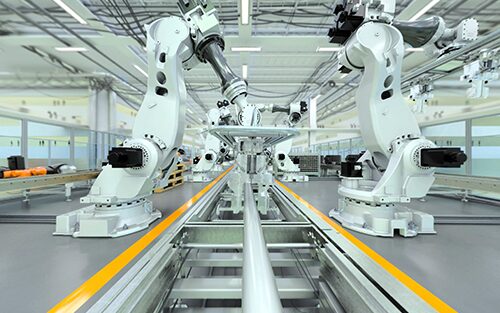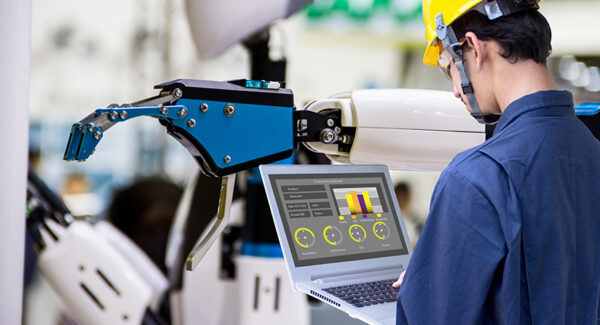The Manufacturing Revolution: How Automation in Manufacturing is Redefining the Industry
In the ever-evolving world of global production, automation in manufacturing is the driving force behind transformative changes. As companies face increasing pressure to meet growing consumer demands, cut costs, and stay ahead of competitors, automation has become a necessity rather than a luxury. With its ability to streamline processes, boost efficiency, and drive technological advancements, automation in manufacturing is revolutionizing the industry in unprecedented ways.
This shift goes beyond simple mechanization. Today, automation in manufacturing incorporates advanced technologies such as artificial intelligence (AI), machine learning, the Internet of Things (IoT), and robotics, collectively known as smart manufacturing systems. These intelligent systems can learn, adapt, and optimize themselves, resulting in faster, more efficient production with improved quality.
The Rise of Smart Manufacturing:
Historically, manufacturing relied heavily on manual labor and basic machinery, often leading to inefficiencies and limited flexibility. Now, with the rise of automation in manufacturing, factories are transitioning into smart environments where real-time monitoring and AI-driven optimization are the norms. These advancements allow manufacturers to:
- Enhance Adaptability:
Automated systems can adjust quickly to changes in production needs, offering flexibility in manufacturing lines and enabling faster responses to market demands. - Optimize Resource Utilization:
Through continuous data collection from sensors and machines, automation in manufacturing helps reduce waste, conserve energy, and allocate resources more efficiently. - Improve Operational Insights:
By gathering real-time data, manufacturers can make informed, data-driven decisions that enhance productivity and reduce costly downtime.
As part of the broader shift towards Industry 4.0—a movement focused on the digital transformation of manufacturing—automation in manufacturing plays a critical role in making factories smarter, more efficient, and highly adaptable. Industry 4.0 technologies are creating interconnected factories capable of self-monitoring and optimization, where predictive maintenance ensures uninterrupted operations.
The Key Benefits of Automation in Manufacturing:
The advantages of automation in manufacturing are extensive, providing opportunities for cost reduction, enhanced productivity, and superior product quality. Some of the most notable benefits include:
- Precision and Quality Control:
Automation in manufacturing brings unparalleled accuracy to production processes. Machines can perform repetitive tasks without human error, ensuring consistent quality and minimizing defects. Automated inspection systems equipped with AI-driven technology can identify flaws in real time, improving overall product reliability. - Increased Productivity:
Automated systems can operate 24/7, significantly increasing production capacity and allowing companies to meet rising global demand. Unlike human workers, automated machines do not require breaks, leading to faster cycle times and quicker turnarounds. Automation in manufacturing also enables businesses to scale their operations without drastically increasing labor costs. - Reduced Labor Costs and Improved Workplace Safety:
By automating repetitive or dangerous tasks, companies can reduce labor costs while also creating safer working environments. Collaborative robots (cobots), a form of automation in manufacturing, are designed to work alongside human employees, assisting with heavy lifting or monotonous tasks. This reduces the risk of workplace injuries while allowing workers to focus on more strategic or creative duties. - Real-Time Data and Predictive Maintenance:
Automation in manufacturing is driven by the power of real-time data. Sensors embedded in machines monitor performance, enabling manufacturers to optimize processes and preemptively address potential issues. Predictive maintenance—one of the most significant breakthroughs in smart manufacturing—alerts operators when machines require servicing, reducing unplanned downtime and extending equipment longevity. - Environmental Sustainability and Energy Efficiency:
Modern automation in manufacturing plays a vital role in sustainability. Automated systems are more energy-efficient, allowing factories to reduce their environmental impact by minimizing waste and optimizing energy use. Smart systems can adjust energy consumption based on production demands, significantly lowering operational costs while promoting greener practices.

Advanced Technologies Powering Automation in Manufacturing:
Several cutting-edge technologies are shaping the future of automation in manufacturing, each playing a crucial role in the way factories operate and deliver products.
- Collaborative Robots (Cobots):
Unlike traditional robots, cobots are designed to work safely alongside humans. They assist with physically demanding or monotonous tasks, such as material handling and assembly, which allows human workers to focus on more complex, high-value activities. Cobots are transforming industries like automotive, electronics, and packaging, enhancing both productivity and worker safety. - AI and Machine Learning:
AI and machine learning are at the heart of automation in manufacturing. These technologies analyze vast amounts of data generated by connected devices, learning from patterns and optimizing processes over time. Machine learning algorithms can predict when equipment will fail, automatically schedule maintenance, and improve overall efficiency in production lines. - 3D Printing (Additive Manufacturing):
Additive manufacturing, or 3D printing, allows manufacturers to create complex parts and components on-demand. This revolutionary approach reduces the need for large inventories and accelerates product development cycles. By enabling customization and reducing material waste, 3D printing is pushing the boundaries of automation in manufacturing in industries such as aerospace, healthcare, and automotive. - IoT and Interconnectivity:
The IoT connects devices, sensors, and machines within a manufacturing facility, allowing them to communicate and share data in real time. This interconnectivity enhances the flow of information, enabling automation in manufacturing to optimize workflows, monitor equipment performance, and improve decision-making across the entire production process.
Overcoming the Challenges of Automation in Manufacturing:
Despite its numerous benefits, adopting automation in manufacturing presents challenges. One of the primary obstacles is the substantial upfront investment required to integrate advanced systems and technologies. Additionally, companies must retrain their workforce to manage and operate automated machinery effectively. There are also concerns about data security, as increased connectivity makes manufacturing systems more vulnerable to cyber-attacks.
However, the long-term advantages of automation in manufacturing far outweigh these challenges. By investing in automation, manufacturers can future-proof their operations, reduce costs, and enhance overall competitiveness in the global market.
The Future of Manufacturing is Automated:
As automation in manufacturing continues to evolve, it’s clear that this trend is shaping the future of the industry. Factories are becoming more intelligent, responsive, and efficient, with real-time data driving production decisions and AI systems predicting potential challenges before they arise. The future of manufacturing lies in fully automated factories that are capable of self-optimizing, learning, and adapting to meet ever-changing market needs.
In this new age, automation in manufacturing is no longer just a tool—it’s the foundation for creating more innovative, flexible, and sustainable manufacturing ecosystems. The companies that embrace automation today will be the leaders of tomorrow, setting the standard for an industry defined by technological advancement and operational excellence.
By adopting automation in manufacturing, businesses are not just increasing productivity—they’re transforming how products are conceived, produced, and delivered across the world, ushering in a new era of industrial innovation.
FAQs:
- What exactly is automation in manufacturing?
Automation in manufacturing involves the use of advanced technologies like robotics, AI, and machine learning to handle various production processes. It automates tasks such as assembly, quality control, and packaging, reducing human involvement and significantly improving efficiency and precision in manufacturing operations. - How does automation boost efficiency in manufacturing?
Automation increases efficiency by performing repetitive tasks faster and with greater accuracy than human workers. Automated systems work continuously, reducing downtime and errors. Real-time monitoring also ensures quick identification of inefficiencies, allowing manufacturers to optimize production flow and resource use. - Which technologies power automation in manufacturing?
Key technologies driving automation include industrial robots, collaborative robots (cobots), AI, machine learning, IoT devices, and 3D printing. These systems create intelligent, adaptive environments that streamline production processes and allow manufacturers to scale efficiently. - Which industries gain the most from automation in manufacturing?
Sectors such as automotive, electronics, pharmaceuticals, aerospace, and food production benefit significantly from automation. These industries demand high precision, consistent quality, and fast production cycles, all of which are enhanced by automated technologies. - Can automation lower labor costs in manufacturing?
Yes, automation helps reduce labor costs by automating routine and labor-intensive tasks. This frees up human workers for more complex roles and strategic functions, leading to cost savings while maintaining operational productivity. - What role does AI play in manufacturing automation?
AI drives intelligent decision-making by analyzing data, predicting trends, and optimizing manufacturing operations. AI-powered systems detect inefficiencies, suggest improvements, and perform predictive maintenance to prevent breakdowns, ensuring smoother production. - How does automation support sustainable manufacturing?
Automation enhances sustainability by minimizing material waste and optimizing energy consumption. Smart factories monitor and adjust operations in real time to reduce excess energy usage, making manufacturing more eco-friendly while lowering operational costs. - What challenges come with implementing automation in manufacturing?
Common challenges include the initial cost of automation equipment, integrating new technology into legacy systems, and retraining employees to work with advanced systems. Manufacturers must also address cybersecurity risks associated with connected devices. - Does automation lead to job displacement in manufacturing?
While some manual tasks may be automated, new roles emerge, particularly in managing and maintaining automated systems. Automation often shifts human roles towards more strategic and creative functions, rather than eliminating jobs altogether. - Is automation feasible for smaller manufacturing businesses?
Absolutely. Today, automation solutions can be scaled to fit small and medium-sized businesses. Technologies like collaborative robots and cloud-based systems are flexible and cost-effective, making it easier for smaller manufacturers to adopt automation and remain competitive. - How does automation improve product quality?
Automation improves product quality by ensuring that every task is performed with precision and consistency. Automated systems reduce the chance of human error, while real-time quality monitoring detects defects early, allowing manufacturers to maintain higher standards. - What is the future outlook for automation in manufacturing?
The future of automation in manufacturing will likely involve fully autonomous factories where AI, IoT, and robotics work together seamlessly. These factories will self-optimize, learn from data, and adapt to new challenges, paving the way for faster, more flexible production. - How can manufacturers get ready for automation?
To prepare, manufacturers should invest in digital transformation, train their workforce on new technologies, and start integrating automation gradually. Collaborating with automation experts and developing a data-driven infrastructure are key steps for a successful transition to smart manufacturing.




